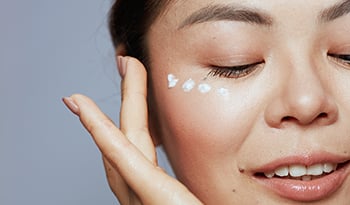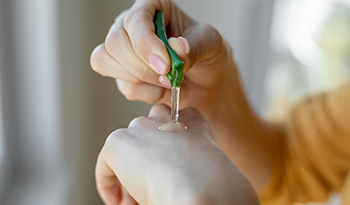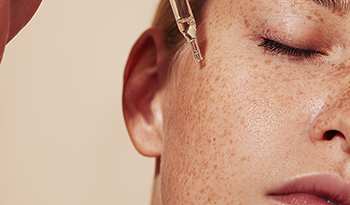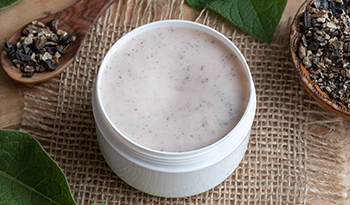4 Korzyści i przypadki użycia oczaru wirginijskiego
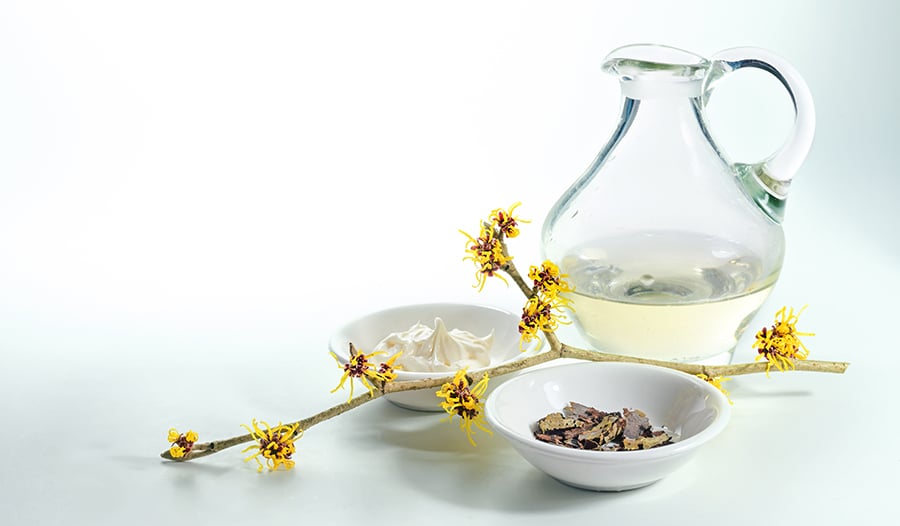
Czym jest oczar wirginijski?
Oczar wirginijski jest miejscowym środkiem ściągającym o wielu zaletach dla skóry. Jest on wytwarzany z liści, kory i gałązek oczaru wirginijskiego (Hamamelis virginiana), który rośnie w Ameryce Północnej. Oczar wirginijski może być ostatnio na twoim radarze, ponieważ stał się popularnym elementem rutynowej pielęgnacji skóry. Oczar wirginijski pomaga poprawić wygląd skóry, ale jego zalety nie kończą się na zmniejszaniu porów i zwalczaniu bakterii wywołujących trądzik.
Czytaj dalej, aby poznać zalety oczaru wirginijskiego dla skóry i skóry głowy , jak go stosować, potencjalne skutki uboczne i dlaczego warto rozważyć włączenie tego prostego produktu do swojej rutyny odnowy biologicznej.
4 zalety oczaru wirginijskiego
Oczar wirginijski to przezroczysty płyn powszechnie stosowany miejscowo na skórę za pomocą wacika. Oferuje szereg korzyści dla skóry i skóry głowy, w tym pomaga złagodzić trądzik, łagodzi wrażliwą skórę głowy oraz zmniejsza stany zapalne i podrażnienia skóry.
Ze względu na zróżnicowane właściwości lecznicze oczaru wirginijskiego, producenci opracowali produkty wykraczające poza wodny środek ściągający, w tym maści, a nawet herbaty zawierające oczar wirginijski. Podczas gdy miejscowe stosowanie oczaru wirginijskiego zapewnia dobrze udokumentowane korzyści przy niewielu, jeśli w ogóle, skutkach ubocznych, spożywanie oczaru wirginijskiego może stanowić większe ryzyko. Niezależnie od tego, czy szukasz sposobu na poradzenie sobie z podrażnieniami lub stanami zapalnymi skóry, czy też cierpisz na schorzenie powodujące nadwrażliwość skóry głowy, dodanie oczaru wirginijskiego do codziennej rutyny może być prostym rozwiązaniem Twoich problemów z urodą.
Pielęgnacja skóry
Trądzik jest powszechną chorobą skóry charakteryzującą się stanem zapalnym skóry. W przypadku trądziku mieszki włosowe zatykają się olejem i martwymi komórkami skóry, co prowadzi do powstawania pryszczy, które mogą być bolesne i uciążliwe pod względem estetycznym.
Trądzik może być spowodowany różnymi czynnikami, w tym hormonami, produktami kosmetycznymi, pogodą i niektórymi lekami. Niezliczone produkty, leki i terapie twierdzą, że pomagają rozwiązać trądzik - często bez powodzenia.
Dzięki swoim właściwościom przeciwzapalnym i ściągającym, oczar wirginijski może być skutecznym, naturalnym składnikiem rutynowej pielęgnacji skóry zwalczającej trądzik . Jako silny środek ściągający, oczar wirginijski obkurcza komórki skóry i pory, pomagając powstrzymać bakterie wywołujące trądzik.
Oczar wirginijski można nakładać bezpośrednio na skórę po jej oczyszczeniu lub stosować produkty przeciwtrądzikowe zawierające oczar wirginijski. Chociaż badania nad wpływem oczaru wirginijskiego na trądzik są ograniczone, jego zastosowanie jako kuracji wydaje się obiecujące, szczególnie dla osób z tłustym typem skóry.
Spożywane pokarmy mogą również wpływać na skórę i nasilać trądzik. Winowajcą może być żywność, która powoduje szybki wzrost poziomu cukru we krwi i z czasem sprzyja insulinooporności. Przetworzone węglowodany, takie jak słodkie płatki zbożowe, białe pieczywo, słodzona granola i batoniki zbożowe oraz napoje słodzone cukrem, to niektóre z produktów spożywczych i napojów, które najczęściej powodują wzrost poziomu cukru we krwi.
Zamiast tego wybieraj pokarmy o wysokiej zawartości błonnika i minimalnej ilości dodanego cukru, takie jak płatki owsiane , krakersy, makaron quinoa i inne produkty pełnoziarniste . , krakersy, makaron, komosa ryżowa i inne produkty pełnoziarniste . . Te pokarmy rzadziej powodują wzrost poziomu cukru we krwi. Dodatkowo, chude białka, owoce, warzywa oraz orzechy i nasiona powinny stanowić dużą część diety.
Wrażliwość skóry głowy
Wrażliwość skóry głowy może być spowodowana problemami dermatologicznymi, takimi jak łuszczyca lub zapalenie skóry, lub niektórymi zabiegami lub produktami do włosów. Łupież, swędzenie skóry głowy i nadmierne przetłuszczanie to jedne z najczęstszych dolegliwości związanych z wrażliwością skóry głowy. Na szczęście przeciwdziałanie tym objawom nie wymaga wiele czasu, pieniędzy ani produktów - często można je poprawić za pomocą prostej, ale skutecznej rutyny pielęgnacji skóry głowy.
Oczar wirginijski może pomóc złagodzić wrażliwość skóry głowy poprzez złagodzenie podrażnień skóry głowy, chociaż badania są ograniczone. W jednym z badań osoby z podrażnieniami skóry głowy, które stosowały szampon z oczaru wirginijskiego przez cztery tygodnie, doświadczyły poprawy wrażliwości i podrażnienia skóry głowy.1
Łatwo jest zapomnieć o skórze głowy pod tymi wszystkimi włosami, ale skóra głowy jest wyjątkowym rodzajem skóry, która wymaga własnej pielęgnacji. Dbanie o skórę głowy może być tak proste, jak przejście na szampon i odżywkę z oczaru wirginijskiego.
Przeciwzapalne
Stan zapalny jest naturalną reakcją ochronną organizmu. Podczas gdy ostry stan zapalny w odpowiedzi na uraz nie wpłynie negatywnie na organizm, przewlekły stan zapalny jest bardziej niepokojący. Na ten rodzaj stanu zapalnego wpływa wiele czynników, w tym dieta i inne warunki zdrowotne, i może on prowadzić do własnego zestawu problemów zdrowotnych, jeśli nie jest kontrolowany.
Oczar wirginijski może pomóc złagodzić miejscowe stany zapalne spowodowane podrażnieniem skóry w wyniku łagodnego oparzenia słonecznego. Garbniki zawarte w oczarze wirginijskim mają właściwości przeciwzapalne i mogą być w stanie złagodzić dyskomfort, obrzęk i tkliwość oparzeń słonecznych. Wystarczy nanieść oczar wirginijski na płatek kosmetyczny i delikatnie przetrzeć oparzenie słoneczne.
Aloes to kolejny naturalny produkt, który może pomóc złagodzić stan zapalny spowodowany oparzeniami słonecznymi. Niektóre produkty łączą aloes z oczarem wirginijskim w celu zwiększenia ulgi. Niezależnie od tego, czy wkrótce wybierasz się na plażę, czy też musisz zaopatrzyć się w niezbędne letnie produkty do opalania, pamiętaj, aby mieć pod ręką produkty do pielęgnacji po opalaniu , które pomogą ukoić skórę po dniu spędzonym na słońcu.
Podrażnienie skóry
Właściwości przeciwzapalne oczaru wirginijskiego mogą również pomóc złagodzić dyskomfort i przyspieszyć gojenie się wysypki. Stosowanie oczaru wirginijskiego bezpośrednio na podrażnioną skórę może pomóc zmniejszyć swędzenie i pieczenie oraz złagodzić wrażliwą skórę.2 Można również nałożyć na skórę balsam zawierający oczar wirginijski.
Spożywanie odpowiednich pokarmów może również pomóc poprawić stan wrażliwej skóry. Pokarmy bogate w niezbędne tłuszcze omega-3, takie jak tuńczyk , łosoś , łosoś i orzechy włoskie mogą pomóc poprawić stan zapalny skóry i wspierać zdrową skórę. 3 Codzienne przyjmowanie suplementów omega-3 może pomóc uporać się z uporczywymi podrażnieniami skóry. Awokado, pomidory i papryka zawierają również zdrowe tłuszcze i mikroelementy, takie jak cynk i witamina C , które wspierają zdrową skórę.
Jak używać oczaru wirginijskiego
Oczar wirginijski jest najczęściej stosowany miejscowo. Aby leczyć trądzik, nadwrażliwość skóry głowy, oparzenia słoneczne lub podrażnienia skóry, nałóż oczar wirginijski bezpośrednio na dotknięty obszar za pomocą wacika. Możesz także używać specjalnie opracowanych produktów zawierających oczar wirginijski, takich jak balsamy lub szampony.
Podczas gdy niektórzy ludzie używają środków ściągających, takich jak oczar wirginijski, do płukania jamy ustnej w celu leczenia owrzodzeń, wewnętrzne stosowanie oczaru wirginijskiego może powodować rozstrój żołądka lub inne poważniejsze problemy zdrowotne. Najlepiej jest unikać spożywania oczaru wirginijskiego, aby zapobiec możliwym szkodliwym skutkom ubocznym.
Najczęstsze skutki uboczne i zagrożenia dla zdrowia oczaru wirginijskiego
Oczar wirginijski jest ogólnie uważany za bezpieczny i pozbawiony skutków ubocznych, gdy jest stosowany miejscowo na choroby skóry. Przyjmowanie dużych ilości oczaru wirginijskiego doustnie może powodować poważne komplikacje i należy tego unikać.
Chociaż nie są znane żadne interakcje między oczarem wirginijskim a innymi produktami spożywczymi, suplementami lub lekami, zawsze dobrze jest skonsultować się z lekarzem przed wprowadzeniem nowego składnika do rutyny odnowy biologicznej. Jeśli rozważasz stosowanie oczaru wirginijskiego na problemy skórne, skonsultuj się z dermatologiem, aby upewnić się, że jest on odpowiedni dla potrzeb Twojej skóry.
Na wynos
Oczar wirginijski jest naturalnym środkiem ściągającym, który może pomóc złagodzić różne dolegliwości skórne. Od wrażliwej i podrażnionej skóry po wrażliwość skóry głowy, miejscowe stosowanie oczaru wirginijskiego jest bezpiecznym i niedrogim lekarstwem. Poszukaj oczaru wirginijskiego jako samodzielnego produktu lub zawartego w specjalnie opracowanych balsamach lub szamponach.
Chociaż oczar wirginijski jest ogólnie wolny od skutków ubocznych, gdy jest stosowany miejscowo, zawsze dobrze jest skonsultować się z zespołem opieki zdrowotnej przed wprowadzeniem nowego produktu lub suplementu do rutyny pielęgnacji skóry lub dobrego samopoczucia.
Referencje:
- Trüeb R. Północnoamerykański oczar wirginijski (Hamamelis virginiana): Pielęgnacja i ochrona skóry głowy wrażliwej, zaczerwienionej i poparzonej. Int J Trichology. 2014;6(3):100.
- Heinicke IR, Adams DH, Barnes TM, Greive KA. Ocena leczenia miejscowego w celu złagodzenia wrażliwej skóry. Clin Cosmet Investig Dermatol. 2015;8:405.
- Thomsen BJ, Chow EY, Sapijaszko MJ. Potencjalne zastosowania kwasów tłuszczowych omega-3 w dermatologii: A Review. J Cutan Med Surg. 2020;24(5):481-494.
WYŁĄCZENIE ODPOWIEDZIALNOŚCI:Celem niniejszej Strefy Zdrowia nie jest stawianie diagnoz...

















































































 Spis treści
Spis treści




